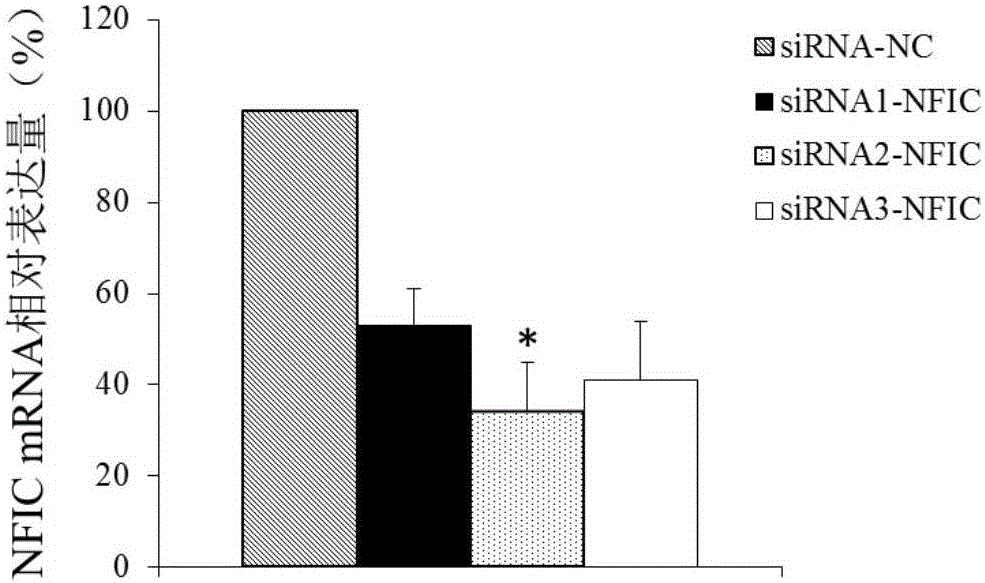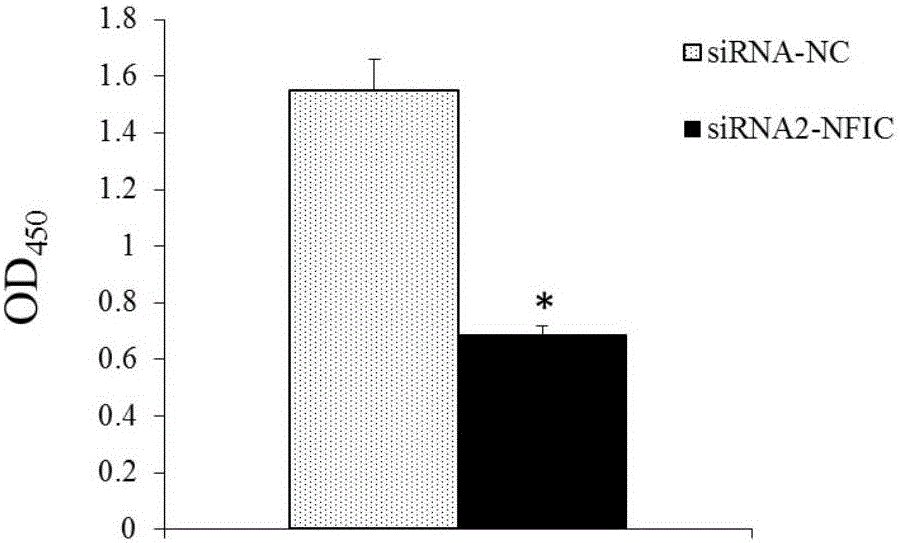Application of NFIC gene in preparation of diagnostic and therapeutic products for pituitary adenomas
A technology for pituitary tumors and products, applied in the field of NFIC gene diagnosis and treatment of pituitary tumors, can solve the problems of high postoperative recurrence rate, difficult complete resection, and high recurrence rate
- Summary
- Abstract
- Description
- Claims
- Application Information
AI Technical Summary
Problems solved by technology
Method used
Image
Examples
Embodiment 1
[0059] Example 1 Differential expression of NFIC gene
[0060] 1. Collect samples
[0061] Patients with pituitary tumors: Among the 10 patients with pituitary tumors, there were 5 males, aged 28-73, with an average age of 47; 5 females, aged 25-68, with an average age of 44. Inclusion criteria: patients underwent transsphenoidal pituitary tumor resection, brain MRI and other imaging data were available before surgery, and postoperative pathological sections confirmed pituitary tumor. With the consent of the hospital ethics committee, the materials were collected after the patients signed the informed consent.
[0062] Normal pituitary gland tissue: 5 cases were taken from the Anatomy Department of the University, and endocrine-related diseases were excluded. The sampling method was the same as that of patients with pituitary tumors.
[0063] The required tissues were taken during the operation, washed with normal saline, immediately put into cryopreservation tubes treated ...
Embodiment 2
[0074] Example 2 qPCR experiment to verify the differential expression of NFIC gene
[0075] 1. Collect samples
[0076] According to the standard of Example 1, 40 patients with pituitary tumors were collected, and their pituitary tumor tissues were collected. 30 normal pituitary tissues were collected.
[0077] 2. RNA extraction
[0078] use Reagent (invitrogen, Cat. No. 15596-018) was used for sample RNA extraction. The specific operation is as follows:
[0079] Collect the samples and freeze them in liquid nitrogen. After taking them out, put the tissue into a pre-cooled mortar for grinding. After the tissue sample is powdered:
[0080] ① Add Trizol and store at room temperature for 5 minutes;
[0081] ② Add 0.2ml of chloroform, vibrate the centrifuge tube vigorously, mix well, and place it at room temperature for 5-10 minutes;
[0082] ③ After 15 minutes of high-speed centrifugation at 12000rpm, suck the upper aqueous phase (absorb 70%) into another new centrifuge ...
Embodiment 3
[0101] Embodiment 3 inhibits NFIC gene expression
[0102] 1. siRNA design and synthesis
[0103] siRNA sequences targeting NFIC:
[0104] siRNA1-NFIC:
[0105] The sense strand is 5'-UCUUCUUCUUCUUCUUCUGCC-3' (SEQ ID NO.7);
[0106] The antisense strand is 5'-CAGAAGAAGAAGAAGAAGAAA-3' (SEQ ID NO.8),
[0107] siRNA2-NFIC:
[0108] The sense strand is 5'-AGAUGAAUAACUUAGGAAGAC-3' (SEQ ID NO.9);
[0109] The antisense strand is 5'-CUUCCUAAGUUAUUCAUCUCC-3' (SEQ ID NO.10),
[0110] siRNA3-NFIC:
[0111] The sense strand is 5'-UAUUGUUUAAAGGUAAUACUU-3' (SEQ ID NO.11);
[0112] The antisense strand is 5'-GUAUUACCUUUAAACAAUAUC-3' (SEQ ID NO.12)
[0113] The above siRNA sequences and negative control siRNA sequences (siRNA-NC) were provided by Shanghai Gemma Pharmaceutical Technology Co., Ltd.:
[0114] 2. Culture and transfection of pituitary tumor cells
[0115] 2.1 Cell culture
[0116] The pituitary tumor tissue pieces were immersed in RPMI-1640 medium, washed 3 times with ...
PUM
 Login to View More
Login to View More Abstract
Description
Claims
Application Information
 Login to View More
Login to View More - R&D
- Intellectual Property
- Life Sciences
- Materials
- Tech Scout
- Unparalleled Data Quality
- Higher Quality Content
- 60% Fewer Hallucinations
Browse by: Latest US Patents, China's latest patents, Technical Efficacy Thesaurus, Application Domain, Technology Topic, Popular Technical Reports.
© 2025 PatSnap. All rights reserved.Legal|Privacy policy|Modern Slavery Act Transparency Statement|Sitemap|About US| Contact US: help@patsnap.com



